Nature doesn’t negotiate: With this succinct appraisal, Greenpeace head Kumi Naidoo sums up the acute need for action to protect our environment and climate. Naidoo, from South Africa, broadly agreed with Hans Wijers – former CEO of coatings and chemicals group AkzoNobel – that the unprecedented challenge of preserving the foundations of life for humanity as a whole requires a massive, concerted effort from all concerned – including a new step forward in the collaboration between business and environmental organizations. As yet, though, this process is still at the stage of overcoming obstacles rather than notching up successes. So at Egon Zehnder’s Amsterdam office, Naidoo and Wijers talked about why short-termism in business is so dangerous when it comes to solving long-term problems like climate change, and why companies and environmentalists alike cannot afford to wait for political solutions. And how taking many small, practical steps could ultimately prove more productive than hoping for one big breakthrough. Climate protection, says Wijers, needs to become a mass movement.
Hans Wijers: Don’t you think it’s a good sign that we’re here together, talking about opportunities for industry and environmental protection organizations to work together? I don’t think we could have imagined such a conversation taking place fifteen or twenty years ago.
Kumi Naidoo: I’m sure you’re right. At that stage, though, the scale of the challenge facing humanity with respect to climate change was equally unforeseeable. Let’s be very clear: We’re not talking about saving the planet, here. The planet doesn’t need saving. Even if humanity continues to follow the path we’re on, the planet will still be here, if rather bruised and battered, and it will actually have a better chance to recover if we’re gone. When we talk about the climate fight, we’re actually talking about protecting our children’s and grandchildren’s future. The scale of the climate challenge is so enormous that neither the business community nor governments nor civil society can deliver a solution alone. This challenge needs a multisector approach. So the fact that we’re considering this here together is an important step in the right direction.
Wijers: I absolutely agree. One problem is that the world isn’t politically organized to deal with problems on this scale. Progress happens very slowly, if at all. There are two things you can do about this: You can complain about it and say: “It’s not going to happen!” Or you can think about trying to organize networks among the various players and stakeholders, trying to find solutions that benefit everyone. If we wait until the necessary political organization is in place we’ll be too late. I think many corporations are aware of this and are working on a response, and I think NGOs are moving in this direction, too. We’re still in the early days, though.
Naidoo: For sure it’s a journey and you’re right to say we’ve got a long way to go. When people ask me how Greenpeace is doing, my honest answer is: “We’re winning some important battles but we’re losing the war.” Climate is not the only issue of concern when you’re talking about sustainability, of course, but if we don’t address the climate issue effectively, everything else is academic. You’re also right that on the one hand corporate leadership has been let down by a failure of political leadership – partly due to the shortcomings of our global governance system. But to be fair I do think there’s another side to this story, which is that in the United States in particular, certain elements of the corporate sector have campaigned aggressively to prevent the government taking leadership on climate.
Wijers: Looking from the corporate sector’s perspective, different companies are in very different places with regard to where they are on that journey. When I say we’re still at the beginning, I mean compared to the challenges that lie ahead.
Naidoo: When people ask me where I think the business community is on this issue, I tell them I can see a spectrum of opinions: Maybe ten percent of business leaders really do recognize that we need to be making complex changes. At the other end of the scale, around ten to fifteen percent of corporate leaders are in denial and trying to block progress. In the middle are the majority of business leaders, who understand that they have to act on sustainability: But the absence of clear leadership from governments – or in other words governments’ failure to deliver regulatory clarity – has tended to be used as an excuse for their failure to take the necessary action. If our governments could summon up the political will to put a price on carbon and send a clear signal to the markets, businesses actually could begin to plan for the future. At the moment, business leaders have no option but to guess how the negotiations will go, how quickly the transition from fossil fuels to clean energy will be made. The problem isn’t just that the journey is a long one. It’s that the majority of political and business leaders are still suffering from a very bad case of cognitive dissonance – and so, even though all the facts are there, we’re running out of time.
Wijers: As a manager of a global company competing with American operations that use cheap coal, you’re faced with a terrible dilemma. Of course a CEO could say: “Let’s use wind and solar energy and nothing else!” – but then that company would be destroyed and the opportunity to make any progress at all would be lost. There are institutional issues we need to address, in order to create the conditions in which bigger changes can happen. Certain technologies are becoming more widely available – but still haven’t moved as far down the cost curve as you would expect, enabling them to have an impact on a massive scale. And this brings us back to politics. In our democratic systems we get the leaders we deserve and the majority of the electorate is rather short term-oriented. Climate change was high on the agenda – before the financial crisis. Now people are more concerned about pensions, healthcare, and whether or not they’ll keep their jobs. If we’re not careful we might find ourselves on a vicious circle, revisiting the same issues, time and again.
Naidoo: I couldn’t agree more. But why is it so hard to generate a sense of urgency? One reason, perhaps, is that you can’t point to the long-term weather changes in the UK, or the drought in California, or Hurricane Sandy in New Jersey and say with hundred-percent certainty that these events are attributable to climate change – even though the causal link is increasingly accepted now. Furthermore, the whole climate debate is so scientifically complex that ordinary people are more or less excluded from it. When I attended my first climate negotiations in Copenhagen, less than a month after I joined Greenpeace, 80 percent of the acronyms and terms I was hearing went straight over my head. Most of the people leading this struggle talk in ways that are inaccessible to the majority – just when we need to invite more people to join the conversation.
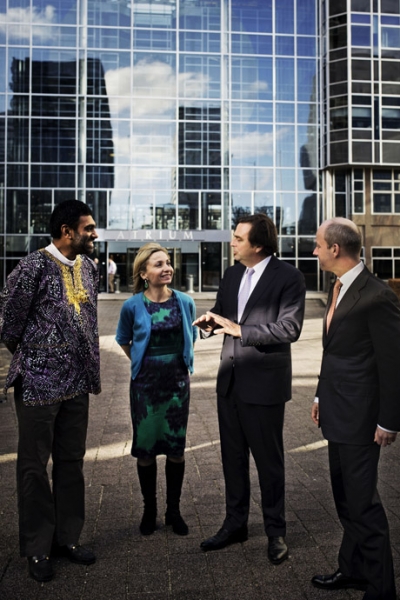
Dominique Laffy, Egon Zehnder London, and Bart Blommers, Egon Zehnder Amsterdam, met with Kumi Naidoo and Hans Wijers in Amsterdam.
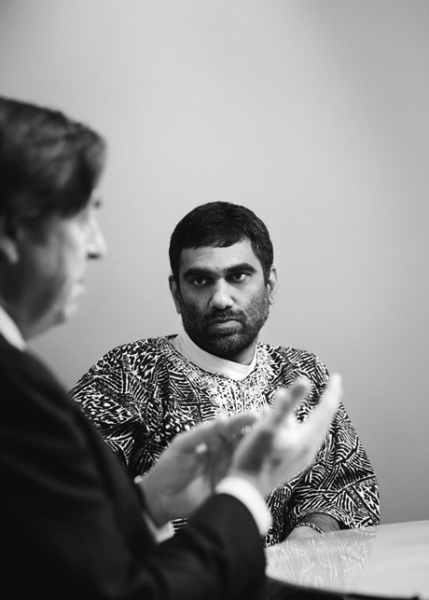
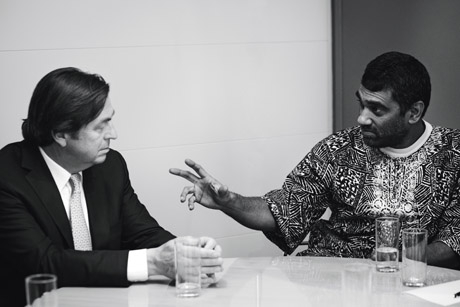
“The education we need right now also involves the realization that some things are ultimately beyond our control.”
- Kumi Naidoo
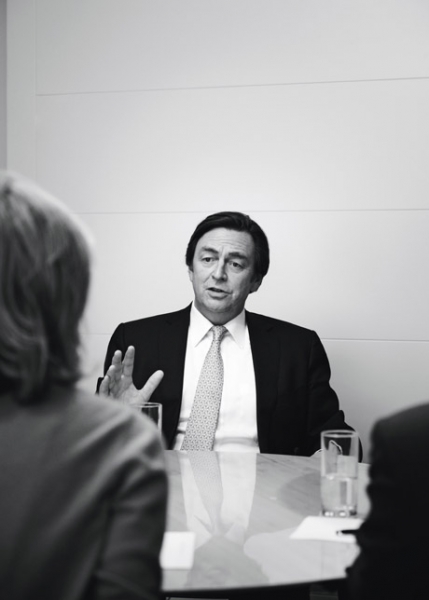
“NGOs and corporations are different animals. Yet in specific situations it can make a lot of sense to work together.”
- Hans Wijers
Wijers: Ultimately, whether we like it or not, change has to have mass support, otherwise we won’t be able to make it happen at all.
Naidoo: I also come to this conversation as an African, someone from the developing part of the world. For us there’s an issue of justice here, too: People in the developing countries have been least responsible for the climate catastrophe they are experiencing, but they are the ones paying the biggest and most brutal price. This was the main reason why I joined the environmental movement. Making the connections between environmental, social, and economic justice is absolutely indispensable. And there’s another important factor, too: Education. The education we need right now also involves the realization that some things are ultimately beyond our control. Let me be quite blunt about that: We have to recognize that nature doesn’t negotiate.
Wijers: That’s very well put.
Naidoo: What we need is an educational drive. I come from an adult education background and one of my major concerns about education is that it’s all about educating people to survive in, and adjust themselves to, a maladjusted world. People are often called ‘maladjusted’ when they don’t fit into society. Well, as Martin Luther King said: “I want to be maladjusted. I want to be maladjusted to the tyranny of racism, to the tyranny of inequality”, and so on. We have to build a more critical element – critical thinking – into education. This is a matter of urgency – if we’re brutally honest we’re running out of ideas and we just don’t have solutions for many of the questions we’re facing.
Wijers: I think one element here is that there’s too much preaching about the consequences of doing nothing – and too little attention given to developing practicable, reasonable short- and medium-term solutions. Everybody supports wind and solar energy, of course – but these energy sources are still very expensive. In the long run, economies of scale will help to address this problem – but most of the scientific research suggests that it will be another 20 or 30 years before this happens. So we need to be more pragmatic, offering solutions that will work in the medium term. Maybe they won’t be as sexy or as appealing as radical solutions and big masterplans – but they will have an impact, without endangering the fundamentals people care about: their jobs and their income.
Naidoo: I’m not arguing against small, pragmatic steps. But – and here I’m addressing the business community in particular – failing to make substantial changes now is not just bad for society and the environment, it’s a suicidal business trajectory, too. The businesses that will survive over the longer term are those that start investing now, reconfiguring their operations to be able to deal with the future. I think a lot of companies are going to be caught with their pants down, attempting to adjust their business strategies when it’s already far too late.
Wijers: When I started at AkzoNobel and tried to talk about sustainability, I hit a wall of skepticism initially. People clearly assumed this was just a new CEO trying to make his mark by introducing his own issues and producing a few brochures. Yet when I toured our operations, when I heard people talking about specific measures they were taking in their labs, in their factories, or on the supplier side – initiatives where they could make an impact – I saw the pride that came from making these positive changes. “What a strange disconnect!” I thought to myself. And I decided to build on this pride and passion, telling everyone in the company about these success stories in order to leverage change elsewhere – creating a momentum in terms of sustainability.
Naidoo: You decided to build the forces for change from below.
Wijers: Exactly. I got a small group of people together and said: “We’re going to make a book. We’ll gather all these good examples together, and we’ll give a copy to all our employees.” When we presented the book at our plants the impact was tangible. People could see this wasn’t about orders from management – it was about what their colleagues elsewhere were already achieving. Basically, the project was a way of disseminating sources of motivation and inspiration – and it worked tremendously well.
Naidoo: How did you address the skeptics?
Wijers: I personally encouraged some of the most skeptical people from the sales and marketing side to talk to their customers about sustainability – to ask these customers directly whether or not sustainability mattered to them. And many of them came back with a very different mindset, seeing sustainability as an opportunity for developing new business proposals and differentiating our offer.
Naidoo: Your story about building from below is exactly what Greenpeace is doing now. We’re restructuring our entire organization, shifting the focus away from our Amsterdam head office. We know that if we win in Europe but don’t win in India, China, Brazil, and Indonesia, then we’ve lost: As incomes grow in these densely populated regions people will want cars and the same consumerist lifestyle, which would be disastrous for the planet. So from this year onward, every global campaign Greenpeace runs will be co-created with our volunteers from Asia, Africa, and Latin America.
Wijers: We had to make sustainability business-relevant, something that made sense in terms of people’s current situation at work. So I asked them to look at it from the cost side: Rather than throwing something away, they could recycle it and create value. This means they aren’t going too far from their comfort zones, they’re dealing with issues that motivate them. If you can generate a feeling of pride, the sense that everyone can make a contribution, you’ll start to see changes happening.
Naidoo: My democratic instincts are very much in favor of bottom-up approaches. But I think we need to be realistic, too, about the time factor. It’s already too late for the people who’ve died from climate impacts in recent years – and we’re talking about nearly 500,000 deaths per year now! It’s too late, too, for parts of the Pacific Island states and parts of Africa. Within this context we need a top-down approach, too, whether we like it or not. In the corporate sector we’re seeing more and more business leaders who are saying: “We need to do more with less.” This is certainly a step in a positive direction in terms of sustainability – but the elephant in the room is that doing more with less is simply not enough. If we’re brutally honest about the planet’s limitations, we have to do less, period. It seems we’re unwilling to negotiate over levels of consumption that are completely unsustainable. Look at the way China’s new elite is behaving: spending their new-found wealth on luxury cars – not one, but five or six parked side by side. If we accept this as normal, if we don’t see such overconsumption as pathological, then we don’t stand a chance. Don’t you think we need to have a conversation about how much production and consumption this planet can actually bear?
Wijers: Here we may disagree. This isn’t necessarily what you’re saying, but I would have concerns about returning to a Soviet-style model in which a few bureaucrats decide what’s good for people and what isn’t. Maybe this is about finding a new way of defining consumption. The real challenge is to provide healthcare, transport, education, holidays, and fun – in ways that consume less energy, less water, fewer raw materials. I’m convinced we can do it. There are billions of people who want to have a comfortable, safe, and healthy lifestyle, a high quality of life. We should be aiming to help people fulfill their needs, in a sustainable way.
“If you can generate a feeling of pride, the sense that everyone can make a contribution, you’ll start to see changes happening.”
- Hans Wijers
“Political and business leaders are still suffering from a very bad case of cognitive dissonance.”
- Kumi Naidoo
Naidoo: Sadly this doesn’t work without putting pressure on companies, where they’re most vulnerable – their consumer base. Greenpeace appeals to consumers, using consumer pressure to bring about corporate change – a tactic known as “brand attack” in the campaigning jargon – and this is proving very effective. The dominant public perception of Greenpeace is all about bold actions – yet what people don’t realize is that 80 percent of what we do is less high-profile, involving seeking solutions, negotiating, and enacting a very simple philosophy: “No permanent enemies, no permanent allies.”
Wijers: I think your independence is very important: It would be both naïve and dangerous for Greenpeace to enter into permanent, “structural” cooperations. NGOs and corporations have different missions and different roles in life: We have to be aware that they are different animals. It’s appropriate for NGOs to be less patient, more passionate about particular issues than corporations, because they have a broader agenda. Yet in specific situations it can make a lot of sense to work together, where there is sufficient alignment in terms of the ultimate end goal.
Naidoo: This is absolutely true in situations where both sides share the same level of awareness. Sadly, forward-looking individuals of this kind are still in short supply in the business sector. Let me give you one example – a major retailer whose value chain is heavily reliant on marine and fish-based products. I invited their entire senior management team to our head office in Amsterdam, and told the CEO of my concerns: By supporting unsustainable fishing practices they were actively contributing to the death of their own industry over the longer term. The CEO, who clearly knew nothing about ocean acidification, an issue we had just put before him, turned to his Vice President for Sustainability and said: “Is this really true, about marine acidification?” – The answer was: “I’m afraid so, sir.” And there was silence in the room.
Wijers: Where cooperation between industry and NGOs is concerned, I think we need to realize that the people involved, on both sides, need to share the same mindsets and values in order to make these cooperations fruitful. They have to be entrepreneurial and interested in more than their own organization. People like the CEO you just quoted clearly lack that broader awareness.
There needs to be a certain degree of openness and cultural awareness, too – and, finally, you need people capable of building relationships of trust. My partner on the other side of the table must have the confidence that I am serious and not just trying to buy time; I must be able to trust that confidentiality will be respected throughout the process.
Naidoo: From the NGO side it’s quite similar. I would just add a willingness to take risks. If we’re going to talk about engaging in a partnership we need to be honest about the power differentials between us – power differentials we’ve inherited with our jobs. We need to be able to structure long-term, difficult, complex relationships, knowing from the outset that there are going to be disagreements, differences, and contradictions. Far too often, partnerships between businesses and the non-profit sector don’t work because people feel we have to pretend that we are absolute equals. In terms of popular support we might be stronger than your company. But in terms of staff numbers, capacity, financial power, or professional skills we cannot match you.
Far too often people feel a strange kind of pressure to pretend that a relationship is working perfectly – that you’re instantly in love with each other. This just can’t work.
Wijers: Ultimately it’s about respect for each other, isn’t it?
Naidoo: Yes, if we can build respect, that will be a huge step forward.
“There are billions of people who want to have a comfortable, safe, and healthy lifestyle. We should be aiming to help them fulfill their needs, in a sustainable way.”
- Hans Wijers
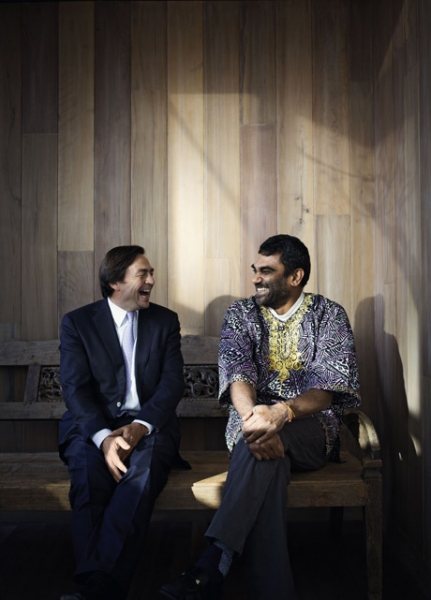
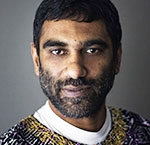
Kumi Naidoo,
has been in charge of the global activities of the environmental organization Greenpeace since 2009. He is the first African (of Indian descent) to take the helm of Greenpeace and the first boss to have joined the organization “through the side door” – that is to say, the first who has not stepped up to the top job after building a career within Greenpeace. Naidoo, born in Durban, South Africa, in 1965, was a committed supporter of the anti-apartheid movement from early adolescence and was frequently detained for civil disobedience. To avoid further arrests, in 1987 he decided to flee to England, where he won a scholarship to Oxford University, completing a doctorate in Political Sociology. When apartheid came to an end, Naidoo led various global campaigns against poverty and for the protection of human rights. Naidoo’s arrival at Greenpeace came at a time when the organization was in urgent need of strategic redirection; its reputation as a force to be reckoned with seemed to have faded. Instead of reverting to the “combat mode” of old, Naidoo wants to make Greenpeace more mainstream, strengthen its global relevance in the political and business spheres, and attain a new dimension of mass protest. One clear change of course is Naidoo’s willingness to collaborate with industry. His aim here is to win the major corporate groups, in particular, as partners in the battle against climate change. For Naidoo, working with business is a means to an end, not a partnership made in heaven: “If somebody could tell me a way we can succeed without getting business on board, we would opt for that. But in my judgment that’s lazy activism. You have to destabilize their thinking.” Naidoo has a 22-year-old daughter who lives in England.
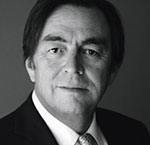
Hans Wijers,
born in Oostburg, the Netherlands, in 1951, ranks among the country’s politically, commercially, and scientifically experienced all-rounders. After studying Economics and obtaining his doctorate with a thesis on Industrial Politics, from 1982 to 1984 he was a civil servant, working with the Ministry of Social Affairs and the Ministry of Economic Affairs. After a period in management consulting, in 1994 Wijers was appointed Minister of Economic Affairs in the government of social democrat Wim Kok and made a name for himself as a modernizer who revamped encrusted structures. After a full term of government he opted to return to Boston Consulting, rising to the rank of Senior Partner. In 2003 Wijers again changed horses and became CEO of the Dutch chemicals and pharmaceuticals group AkzoNobel. Under his aegis, this conglomerate was transformed into an out-and-out chemicals group and the world’s largest paint manufacturer. Wijers remained at the helm of AkzoNobel until he stepped down in April 2012. Alongside his roles as CEO and minister, Wijers has always been active as a company director and in a voluntary capacity, not least as President of the World Wildlife Fund (WWF) Holland, as a Non-Executive Director of Royal Dutch Shell and as Chairman of Ajax Amsterdam. Since last year he has been Chairman of the Board of Heineken, the world’s third-largest brewery group. Observers refer to Wijers with his outstanding connections in the political and commercial spheres as a “gifted tactician,” invariably friendly, humorous, and jovial in his approach. Wijers, who loves football, music, and art, lives in Amsterdam with his wife, the gynecologist Edith A. Sijmons. The couple has two children aged 19 and 21.
PHOTOGRAPHY: FRITZ BECK
 Shaping Successions
Shaping Successions
 Advancing Governance
Advancing Governance
 Discovering Leaders
Discovering Leaders
 Developing Leadership
Developing Leadership